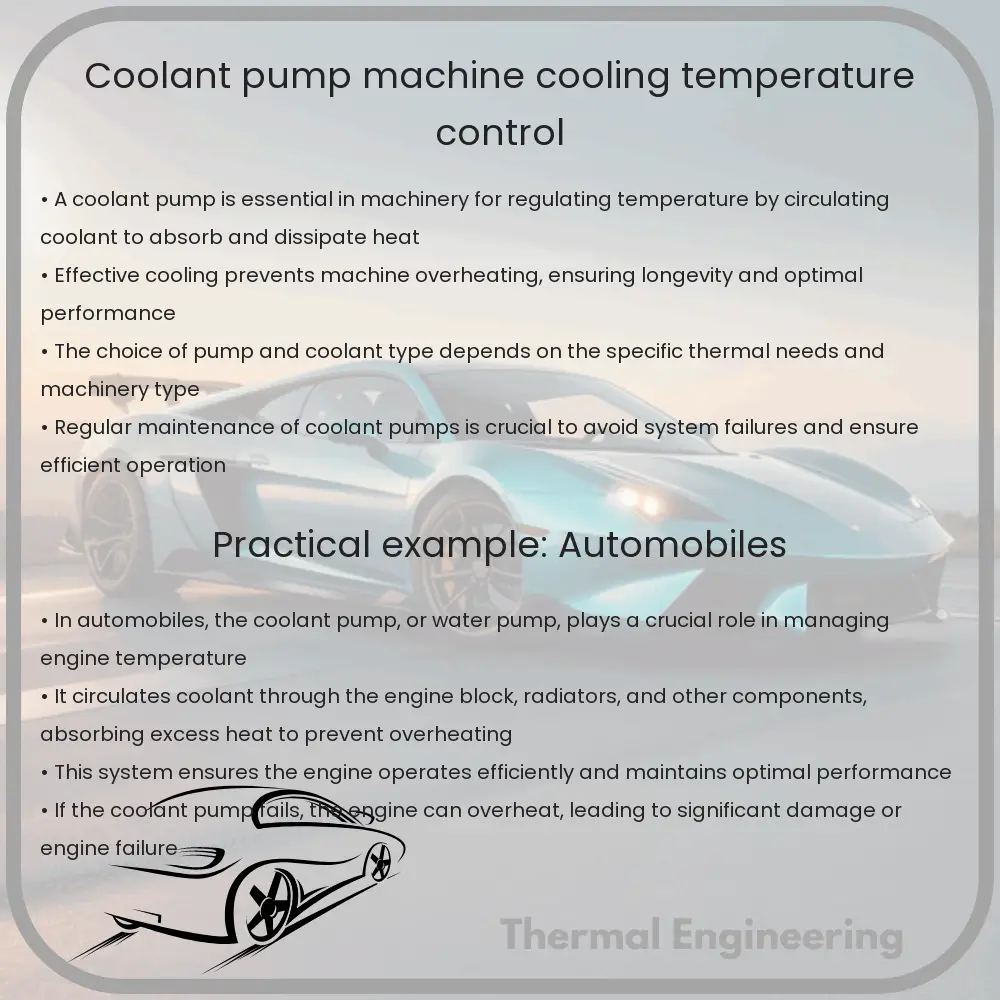Learn about coolant pumps, their types, working mechanisms, and key factors in selection for machine cooling and temperature control systems.

Understanding Coolant Pumps in Machine Cooling and Temperature Control
Maintaining an optimal temperature during the operation of industrial machinery and equipment is crucial for efficiency and longevity. This is where coolant pumps play an indispensable role. A coolant pump is designed to regulate the temperature of machines and prevent overheating, which could potentially lead to mechanical failures and downtime. Let’s explore how coolant pumps function, their types, and some basic calculations involved in selecting the right pump.
How Do Coolant Pumps Work?
Coolant pumps are typically part of a cooling system that circulates coolant — usually water-based or oil-based liquids — through machinery to absorb excess heat. The basic mechanism involves drawing the heated coolant away from the machine’s hot surfaces, pumping it to a cooling unit, and then recirculating the cooled fluid back into the system. This continuous flow of coolant helps maintain a stable operating temperature within the machinery.
Types of Coolant Pumps
- Centrifugal Pumps: These are the most common type used in industrial applications. They operate using a rotating impeller to create centrifugal force, pushing fluid outward from the pump’s inlet to its outlet, thereby facilitating the movement of the coolant.
- Positive Displacement Pumps: These pumps move a fixed amount of fluid per cycle through displacement of the liquid with gears, screws, or vanes. They are typically used where a precise volume of fluid is required to be moved, regardless of the pressure or viscosity.
- Submersible Pumps: Designed to operate while submerged in the coolant itself, submersible pumps are highly efficient as they don’t require a lot of energy to move the coolant into the pump. They are commonly used in machine tool applications.
Key Factors in Selecting a Coolant Pump
Several factors should be considered when selecting a coolant pump for industrial applications:
- Flow Rate: The flow rate, typically measured in gallons per minute (GPM) or liters per minute (LPM), is crucial. It must be sufficient to remove heat from the machine effectively.
- Head Pressure: The pump must provide enough pressure to circulate the coolant through the entire cooling system, overcoming resistance created by pipes, fittings, and equipment.
- Coolant Type: The type of coolant used can affect the pump’s material and design, especially if the coolant is abrasive or chemically aggressive.
- Energy Efficiency: An energy-efficient pump can significantly reduce operational costs, especially in systems that operate continuously.
- Durability and Maintenance: The pump’s construction should be robust enough to handle the operating conditions, and maintenance should be straightforward to minimize downtime.
Basic Calculation for Coolant Pump Selection
To select the right coolant pump, understanding the basic equation for hydraulic power is essential:
Hydraulic Power (HP) = (Flow Rate (GPM) * Head Pressure (psi)) / 1714
This equation helps in calculating the required horsepower to overcome the system resistance and maintain adequate flow. By ensuring the pump has a slightly higher capacity than calculated, you can account for any system variations or future expansions.
Conclusion
Coolant pumps are vital components in machine cooling and temperature control systems. Choosing the right pump requires a thorough understanding of the system’s requirements and operating conditions. Whether for industrial machinery, automotive applications, or HVAC systems, effective cooling is essential to protect equipment and optimize performance, highlighting the critical role of coolant pumps in engineering and maintenance strategies.